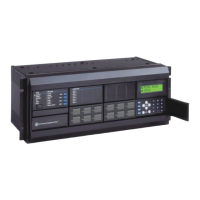5-172 G60 Generator Protection System GE Multilin
5.6 GROUPED ELEMENTS 5 SETTINGS
5
•The POWER SWING UN/BLOCK FlexLogic operand shall be used to block those protection elements that are intended to
be blocked under power swings, but subsequently unblocked should a fault occur after the power swing blocking con-
dition has been established.
•The POWER SWING 50DD FlexLogic operand indicates that an adaptive disturbance detector integrated with the ele-
ment has picked up. This operand will trigger on faults occurring during power swing conditions. This includes both
three-phase and single-pole-open conditions.
•The
POWER SWING INCOMING FlexLogic operand indicates an unstable power swing with an incoming locus (the locus
enters the inner characteristic).
•The POWER SWING OUTGOING FlexLogic operand indicates an unstable power swing with an outgoing locus (the
locus leaving the outer characteristic). This operand can be used to count unstable swings and take certain action only
after pre-defined number of unstable power swings.
•The POWER SWING TRIP FlexLogic operand is a trip command.
The settings for the power swing detect element are described below:
• POWER SWING FUNCTION: This setting enables and disables the entire power swing detection element. The setting
applies to both power swing blocking and out-of-step tripping functions.
• POWER SWING SOURCE: The source setting identifies the signal source for both blocking and tripping functions.
• POWER SWING SHAPE: This setting selects the shapes (either “Mho” or “Quad”) of the outer, middle and, inner char-
acteristics of the power swing detect element. The operating principle is not affected. The “Mho” characteristics use the
left and right blinders.
• POWER SWING MODE: This setting selects between the two-step and three-step operating modes and applies to
both power swing blocking and out-of-step tripping functions. The three-step mode applies if there is enough space
between the maximum load impedances and distance characteristics of the relay that all three (outer, middle, and
inner) characteristics can be placed between the load and the distance characteristics. Whether the spans between
the outer and middle as well as the middle and inner characteristics are sufficient should be determined by analysis of
the fastest power swings expected in correlation with settings of the power swing timers.
The two-step mode uses only the outer and inner characteristics for both blocking and tripping functions. This leaves
more space in heavily loaded systems to place two power swing characteristics between the distance characteristics
and the maximum load, but allows for only one determination of the impedance trajectory.
• POWER SWING SUPV: A common overcurrent pickup level supervises all three power swing characteristics. The
supervision responds to the positive sequence current.
• POWER SWING FWD REACH: This setting specifies the forward reach of all three mho characteristics and the inner
quadrilateral characteristic. For a simple system consisting of a line and two equivalent sources, this reach should be
higher than the sum of the line and remote source positive-sequence impedances. Detailed transient stability studies
may be needed for complex systems in order to determine this setting. The angle of this reach impedance is specified
by the
POWER SWING FWD RCA setting.
• POWER SWING QUAD FWD REACH MID: This setting specifies the forward reach of the middle quadrilateral charac-
teristic. The angle of this reach impedance is specified by the POWER SWING FWD RCA setting. The setting is not used if
the shape setting is “Mho”.
• POWER SWING QUAD FWD REACH OUT: This setting specifies the forward reach of the outer quadrilateral charac-
teristic. The angle of this reach impedance is specified by the
POWER SWING FWD RCA setting. The setting is not used if
the shape setting is “Mho”.
• POWER SWING FWD RCA: This setting specifies the angle of the forward reach impedance for the mho characteris-
tics, angles of all the blinders, and both forward and reverse reach impedances of the quadrilateral characteristics.
• POWER SWING REV REACH: This setting specifies the reverse reach of all three mho characteristics and the inner
quadrilateral characteristic. For a simple system of a line and two equivalent sources, this reach should be higher than
the positive-sequence impedance of the local source. Detailed transient stability studies may be needed for complex
systems to determine this setting. The angle of this reach impedance is specified by the
POWER SWING REV RCA setting
for “Mho”, and the
POWER SWING FWD RCA setting for “Quad”.
• POWER SWING QUAD REV REACH MID: This setting specifies the reverse reach of the middle quadrilateral charac-
teristic. The angle of this reach impedance is specified by the POWER SWING FWD RCA setting. The setting is not used if
the shape setting is “Mho”.

